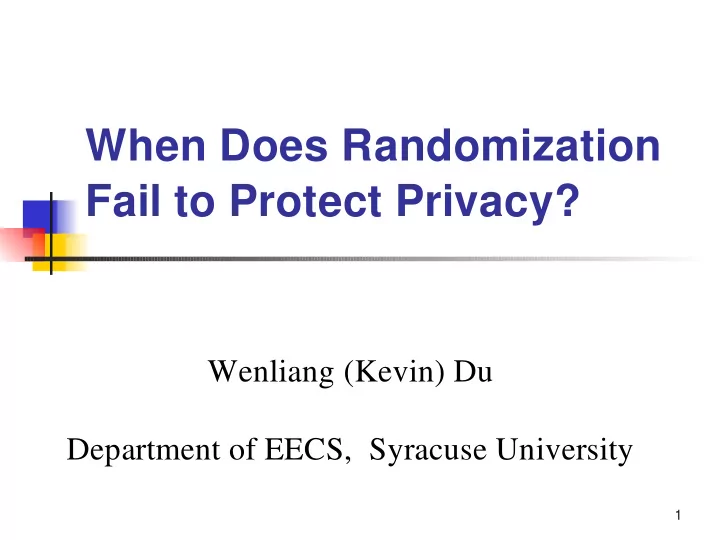

When Does Randomization Fail to Protect Privacy? Wenliang (Kevin) Du Department of EECS, Syracuse University 1
Random Perturbation Agrawal and Srikant’s SIGMOD paper. Y = X + R Original Data X Random Noise R Disguised Data Y + 2
Random Perturbation Most of the security analysis methods based on randomization treat each attribute separately. Is that enough? Does the relationship among data affect privacy? 3
As we all know … We can’t perturb the same number for several times. If we do that, we can estimate the original data: Let t be the original data, Disguised data: t + R 1 , t + R 2 , …, t + R m Let Z = [(t+R 1 )+ … + (t+R m )] / m Mean: E(Z) = t Variance: Var(Z) = Var(R) / m 4
This looks familiar … This is the data set (x, x, x, x, x, x, x, x) Random Perturbation: (x+r 1 , x+r 2 ,……, x+r m ) We know this is NOT safe. Observation: the data set is highly correlated. 5
Let’s Generalize! Data set: (x 1 , x 2 , x 3 , ……, x m ) If the correlation among data attributes are high, can we use that to improve our estimation (from the disguised data)? 6
Introduction A heuristic approach toward privacy analysis Principal Component Analysis (PCA) PCA-based data reconstruction Experiment results Conclusion and future work 7
Privacy Quantification: A Heuristic Approach Our goal: to find a best-effort algorithm that reconstructs the original data, based on the available information. Definition n m 1 ∑∑ = * ( , ) P M L D D ⋅ F i , j i , j n m = = i 1 j 1 8
How to use the correlation? High Correlation Data Redundancy Data Redundancy Compression Our goal: Lossy compression: We do want to lose information, but We don’t want to lose too much data, We do want to lose the added noise. 9
PCA Introduction The main use of PCA: reduce the dimensionality while retaining as much information as possible. 1 st PC: containing the greatest amount of variation. 2 nd PC: containing the next largest amount of variation. 10
Original Data 11
After Dimension Reduction 12
For the Original Data They are correlated. If we remove 50% of the dimensions, the actual information loss might be less than 10%. 13
For the Random Noises They are not correlated. Their variance is evenly distributed to any direction. If we remove 50% of the dimensions, the actual noise loss should be 50%. 14
Data Reconstruction Applying PCA Find Principle Components: C = Q Λ Q T Set to be the first p columns of Q. Q Reconstruct the data: = T X Y Q Q = + = + T T T ( X R ) Q Q X Q Q R Q Q 15
Random Noise R How does affect accuracy? T R Q Q Theorem: p = T ( ) ( ) , V a r R Q Q V a r R m 16
How to Conduct PCA on Disguised Data? Estimating Covariance Matrix = + + ( , ) ( , ) C o v Y Y C o v X R X R i j i i j j + σ = 2 C o v ( X , X ) , fo r i j = i j ≠ C o v ( X , X ), fo r i j i j 17
Experiment 1: Increasing the Number of Attributes Uniform Distribution Normal Distribution 18
Experiment 2: Increasing the number of Principal Components Uniform Distribution Normal Distribution 19
Experiment 3: Increasing Standard Deviation of Noises Normal Distribution Uniform Distribution 20
Conclusions Privacy analysis based on individual attributes is not sufficient. Correlation can disclose information. PCA can filter out some randomness from a highly correlated data set. When does randomization fail: Answer: when the data correlation is high. Can it be cured? 21
Future Work How to improve the randomization to reduce the information disclosure? Making random noises correlated? How to combine the PCA with the univariate data reconstruction? 22
Recommend
More recommend